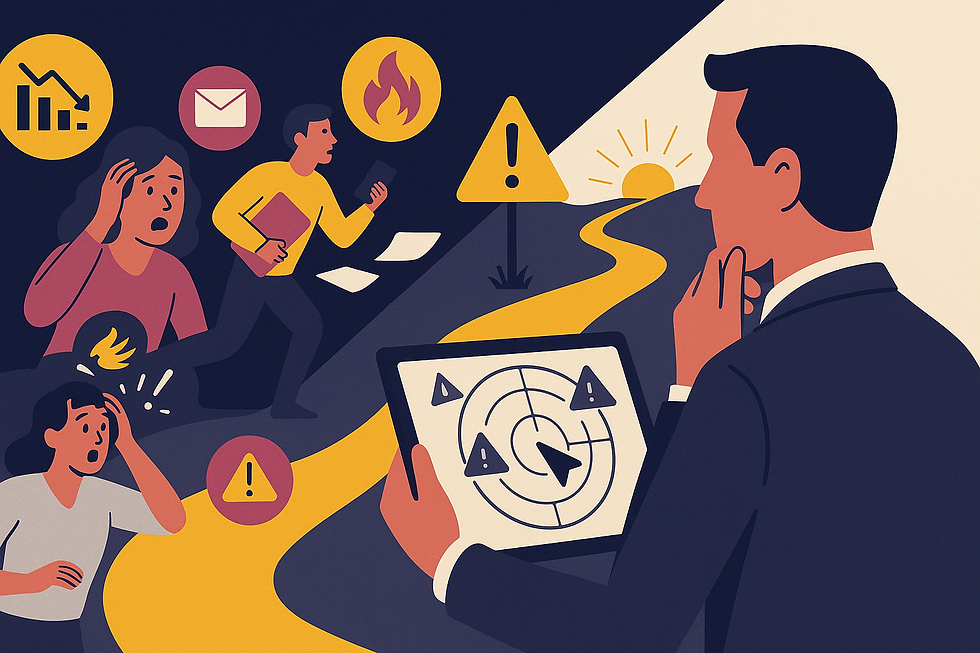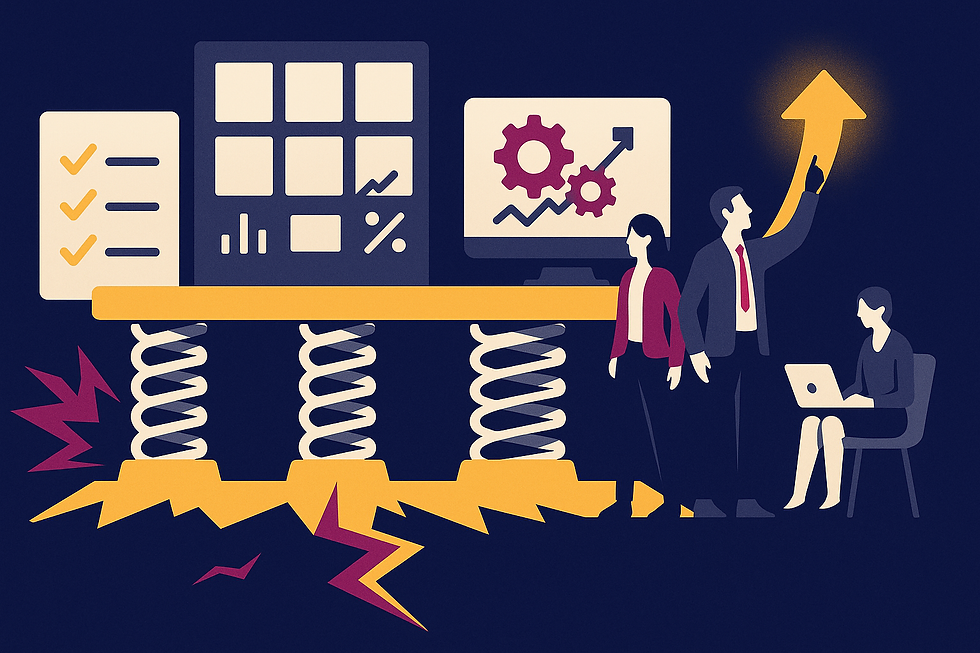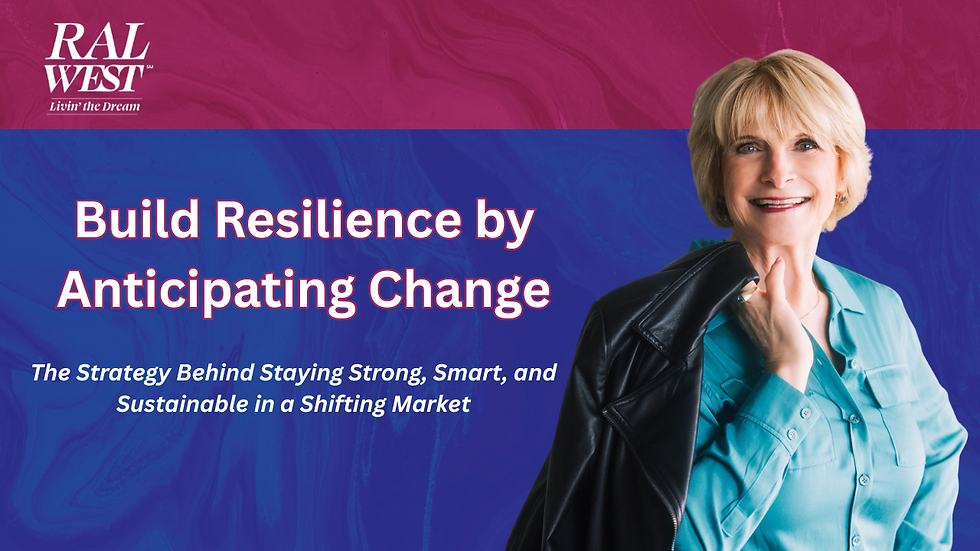Build Resilience by Anticipating Change
- bryan6708
- Aug 29
- 5 min read
The Strategy Behind Staying Strong, Smart, and Sustainable in a Shifting Market
Introduction: Resilience Is Not a Reaction—It’s a Strategy
Entrepreneurship isn’t static.
Markets shift.
Trends evolve.
Technology leaps ahead.
And what worked last year may be obsolete by next quarter.
If you’re waiting for problems to land before you start solving them, your business is already falling behind.
But resilience isn’t about brute strength.
It’s about foresight.
It’s about positioning yourself so that when change comes—and it will—you’re not scrambling to catch up.
You’re already two steps ahead.
I know this from experience.
Years ago, when we ran our scheduled charter airline service, we started to notice something: Alaska Airlines was beginning to make moves in our exact market.
We could have waited.
We could have competed.
We could have crossed our fingers and hoped for the best.
Instead, we moved.
We approached them with a proposal.
We sold the company before they became a competitor.
And it turned out to be one of the smartest strategic decisions we ever made.
That’s what business resilience looks like: seeing change coming—and making the first move.
Part 1: Resilience Isn’t About Bouncing Back—It’s About Being Ready

Most people think of resilience as the ability to “bounce back” from tough times.
But in business, that’s a limited definition.
Real resilience is about building the strength, systems, and foresight to reduce the impact of challenges—or avoid them altogether.
Here’s what that means practically:
You’re not scrambling when a competitor undercuts your pricing—you already have differentiation.
You’re not panicking when a client churns—you’ve got predictable lead flow.
You’re not stuck when your team member quits—you have documented systems.
You can’t predict everything. But you can prepare.
And preparation is power.
Part 2: Anticipate, Don’t Just React

The most resilient businesses have something in common: they read the signs.
They don’t just focus on what’s happening inside their business.
They pay attention to what’s happening around their business.
This was key in our own story.
We didn’t wait for Alaska Airlines to take market share.
We noticed the signals early—industry conversations, fleet expansion, route research.
And that gave us the upper hand.
You can do the same in your industry.
🔍 How to Track the Right Signals:
✅ Watch Your Industry
What tech innovations are emerging?
What are your customers struggling with?
What trends are gaining traction?
Set a reminder every month to scan your industry news. Subscribe to 2–3 well-curated newsletters in your field.
✅ Watch Your Competitors
Are they hiring? Launching new offers? Entering new markets?
Are they shrinking or growing?
Tools like Google Alerts or social media monitoring make this easy.
✅ Watch the Economy
Are there macro trends affecting buying behavior, like interest rates or consumer spending?
Are your customers facing pressure—and how can you adapt?
📌 The goal is not to be paranoid. It’s to be aware—so you’re not blindsided.
Part 3: Know When to Pivot, Partner, or Exit

Resilience isn’t just about surviving hard times.
It’s about having options.
In business, there’s power in:
Pivoting early
Partnering strategically
Exiting on your terms
The Alaska Airlines example isn’t just about selling.
It’s about recognizing that a strategic move can protect your hard work—and even turn a potential threat into a win.
💡 When to Consider a Pivot:
Your current model is profitable, but you’re losing momentum.
Customer needs are changing—and your offer isn’t keeping up.
You’re stuck delivering services that drain your time and energy.
A pivot doesn’t mean starting over.
It means refining your direction to stay aligned with your vision and the market.
🤝 When to Partner:
A competitor has resources you don’t—but you have something they need.
A supplier or platform could become a revenue-sharing ally.
Collaboration can bring mutual leverage.
Partnerships are a resilience multiplier—especially when you’re navigating growth.
🚪 When to Exit:
Your business has value—but you’re not the best person to lead it into the next phase.
A buyer sees a strategic opportunity in what you’ve built.
The market timing is right.
📌 An exit isn’t failure—it’s a form of success. And when done proactively, it can be a huge win.
Part 4: Build Systems That Absorb Shock

You can’t see every challenge coming—but you can build a business that handles change well.
Here’s where systems help you stay resilient:
🧾 1. Financial Systems
Track cash flow weekly
Create a 3–6 month buffer
Automate bill pay and invoicing
This reduces panic during a downturn and ensures decisions are based on reality—not emotion.
👥 2. Team Systems
Cross-train your team
Document key tasks
So if someone’s out, quits, or you need to shift responsibilities, you don’t start from scratch.
🗂 3. Client Experience Systems
Set expectations clearly
Automate onboarding
Keep communication consistent
A consistent customer journey builds trust—especially during external uncertainty. Make sure you are in sync with your clients’ needs, desires and feelings about your business.
📊 4. Visibility Systems
Track key performance metrics (sales, expenses, retention)
Set up simple dashboards (Google Sheets works just fine)
Review your numbers regularly
So you’re not surprised by performance shifts—you catch them early.
(To learn more strategies, watch my FREE tranining video, The 6 Principles for Lasting Business Success)
Part 5: Loyalty and Reputation Are Long-Term Resilience Assets

In a world full of transactional business models, loyalty is an advantage most people underestimate.
Why loyalty matters:
Clients stay longer
Referrals come more naturally
Competitors have a harder time pulling people away
📌 We built our charter air service business on this. Long before tech tools gave companies an edge, we earned our edge through trust, reliability, and personal care. We focused on delighting our customers.
And when we prepared to exit, we had a strong brand, loyal clients, and a reputation that added intangible value to the sale. That made it difficult for anyone to win our market share.
Part 6: The Role of Leadership in Resilience
Resilience starts at the top.
As the founder or CEO, you don’t need to have all the answers.
But you do need to:
Model adaptability
Stay calm under pressure
Communicate clearly with your team
Make decisions with both data and instinct
When your team sees you leading with clarity, they follow with confidence—even when things get tough.
How to Lead Through Change:
Be transparent (not everything is perfect—and that’s okay)
Frame challenges as opportunities to learn
Invite solutions from your team
Focus on progress, not perfection
📌 In our business, when things were uncertain, we didn’t hide it. We brought the team in and brainstormed solutions. That created alignment, buy-in, and better ideas.
Conclusion: Future-Proof Your Business—One Decision at a Time
You don’t have to predict the future.
But you do need to plan for it.
Resilient businesses are built one choice at a time:
✅ Choosing to watch the landscape, not just your to-do list
✅ Choosing to pivot, partner, or exit before you're forced to
✅ Choosing systems that scale and support your team
✅ Choosing loyalty, leadership, and legacy over short-term wins
When you build with resilience in mind, you create a business that’s not just profitable—but durable.
And in a world that’s always shifting, that’s the greatest advantage of all.
Reflection Prompt:
How have you future-proofed your business—or what change are you preparing for now?
Hit reply and let me know. I’d love to hear your strategy.
🎧 Podcast Spotlight: Visibility Strategies for Women Entrepreneurs
I recently had the pleasure of joining Tori Barker on the Visibility Strategies for Women Entrepreneurs podcast. We talked about how to stop being the bottleneck in your business by shifting from operator to owner—and how that shift unlocks more freedom, profit, and visibility.
🎙️ Listen here:
P.S. Want help building a business that can grow and adapt—without exhausting you?
Watch my free training video here: https://www.ralwest.com/six-principles
Or check out my Mastermind, designed to teach entrepreneurs like you to build scalable systems and make confident decisions https://www.ralwest.com/mastermind
Subscribe to my YouTube channel for insights on business systems, leadership, and entrepreneurial freedom: https://www.youtube.com/@RalWest
What was your biggest takeaway from this week's newsletter?





Comments